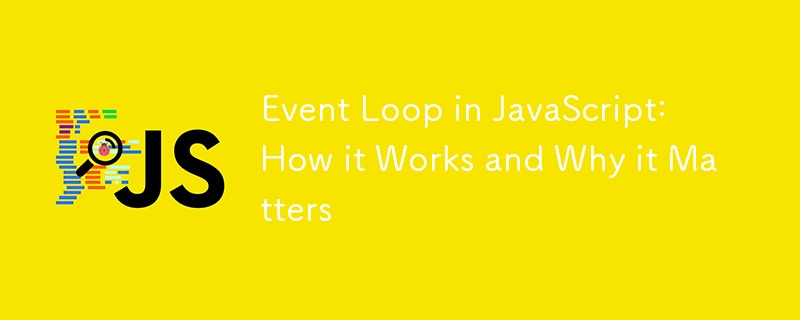
JavaScript 尽管很简单,但其背后运行着一个复杂而强大的引擎。该引擎最关键的方面之一是事件循环。了解事件循环对于 JavaScript 开发人员至关重要,因为它在处理异步操作、确保代码顺利执行和优化性能方面发挥着重要作用。在本文中,我们将深入研究 JavaScript 中的事件循环、它的工作原理、它的重要性,并提供实际示例来巩固您的理解。
事件循环是 JavaScript 运行时的基本组成部分,负责管理多段代码的执行、处理异步事件并确保 JavaScript 引擎高效运行。它允许 JavaScript 成为非阻塞和单线程,从而可以在不冻结用户界面的情况下处理多个任务。
要了解事件循环的工作原理,必须掌握所涉及的关键组件:
事件循环不断检查调用堆栈和回调队列。当调用堆栈为空时,它从队列中取出第一个回调并将其推送到调用堆栈上,然后执行它。
这是一个简单的例子来说明事件循环:
console.log('Start');
setTimeout(() => {
console.log('Timeout');
}, 0);
console.log('End');
预期输出:
Start End Timeout
在此示例中,console.log('Start') 和 console.log('End') 首先执行,因为它们是同步操作并被推送到调用堆栈上。 setTimeout 函数是一个异步操作,因此它的回调会被推送到回调队列中,只有在调用堆栈为空后才会执行。
理解事件循环至关重要,原因如下:
与传统回调相比,Promise 提供了一种更具可读性的方式来处理异步操作。
console.log('Start');
fetch('https://jsonplaceholder.typicode.com/posts/1')
.then(response => response.json())
.then(data => {
console.log('Data:', data);
});
console.log('End');
预期输出:
Start
End
Data: {userId: 1, id: 1, title: '...', body: '...'}
在此示例中,fetch 函数返回一个 Promise,该 Promise 在网络请求完成时解析。 then方法用于异步处理响应,保证调用栈不被阻塞。
Async/await 语法使异步代码的外观和行为类似于同步代码,从而提高了可读性。
console.log('Start');
async function fetchData() {
const response = await fetch('https://jsonplaceholder.typicode.com/posts/1');
const data = await response.json();
console.log('Data:', data);
}
fetchData();
console.log('End');
预期输出:
Start
End
Data: {userId: 1, id: 1, title: '...', body: '...'}
这里,fetchData 函数使用await 来暂停执行,直到 fetch 返回的 Promise 被解析,从而使代码更易于阅读和维护。
The Event Loop processes two types of tasks: macrotasks and microtasks. Understanding the difference between them is crucial for optimizing your code.
Macrotasks: These include events like setTimeout, setInterval, and I/O operations. They are queued in the callback queue and executed one at a time.
Microtasks: These include Promises and mutation observers. They are queued in the microtask queue and executed immediately after the current operation completes, but before any macrotasks.
console.log('Start');
setTimeout(() => {
console.log('Timeout');
}, 0);
Promise.resolve().then(() => {
console.log('Promise');
});
console.log('End');
Expected Output:
Start End Promise Timeout
In this example, the Promise is a microtask and is executed before the setTimeout macrotask, even though both are scheduled to run after the current stack is clear.
How does the Event Loop handle DOM events?
The Event Loop handles DOM events through the Web APIs, which queue the event callbacks to the callback queue when the event is triggered. These callbacks are then processed by the Event Loop.
Can the Event Loop process multiple callbacks simultaneously?
No, the Event Loop processes one callback at a time. JavaScript is single-threaded, so it can only handle one operation at a time in the call stack.
What happens if a callback takes too long to execute?
If a callback takes too long, it can block the call stack, causing delays in processing other callbacks. This can lead to a sluggish user interface. To prevent this, break down long-running operations into smaller tasks using asynchronous techniques.
How do Web Workers relate to the Event Loop?
Web Workers run in separate threads from the main JavaScript execution thread, allowing you to perform background tasks without blocking the Event Loop. Communication between the main thread and Web Workers is handled via message passing.
Why is understanding the Event Loop important for performance optimization?
By understanding the Event Loop, developers can write more efficient code that handles asynchronous operations better, reduces blocking, and ensures smoother user interactions.
How do async/await and Promises fit into the Event Loop?
Async/await and Promises are abstractions over the Event Loop's asynchronous handling. Promises are microtasks that execute after the current stack is clear, and async/await syntax provides a cleaner way to write and manage these asynchronous operations.
The Event Loop is a core concept in JavaScript that ensures efficient execution of code, handling asynchronous operations smoothly, and maintaining a responsive user interface. Understanding how it works and leveraging its capabilities can significantly improve your coding skills and the performance of your JavaScript applications. Whether you're handling simple callbacks or complex asynchronous operations, mastering the Event Loop is essential for any JavaScript developer.
以上是JavaScript 中的事件循环:它是如何工作的以及为什么它很重要的详细内容。更多信息请关注PHP中文网其他相关文章!




